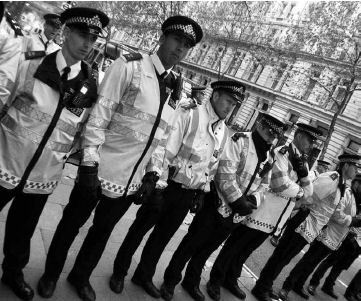At Occupy LSX we have been involved in a continuous process of negotiation with the Metropolitan Police. We maintain a constructive relationship in order to ensure the safety and security of our protest and do not seek confrontation. However, as activists, we need to ask ourselves about the role of the police.
Why have kettling tactics and riot gear been replaced by cops who are more friendly and approachable? Are these officers, who have become a constant presence around the camp, really our friends and potential allies? Who exactly are the police and what is their role in our society? What attitude should we have to them and how should we interact with them? As our presence at St. Paul’s becomes more permanent, we have to find answers to these questions.
The Story So far
On October 15, the initial Occupy LSX protest march was kettled by police and prevented from reaching the London Stock Exchange. The police had deployed officers in full riot gear; units from the Tactical Support Group (TSG) and the Forward Intelligence Teams (FIT) surrounded a peaceful protest. Eight people were arrested.
That evening, senior officers entered the camp and demanded the clearing of the St. Paul’s front steps, apparently out of concern over damage to “the pillars of St. Paul’s”. As the general assembly began discussing the issue, 30 to 40 officers entered the scene and attempted to remove protesters.
When the campers refused to leave after a standoff, the police presence was reduced. Somewhere in the corridors of power a decision had presumably been made that images of the Metropolitan Police beating peaceful protesters on the steps of St Pauls Cathedral would risk public outrage similar to that which occurred at the Wall Street protests.
To date the police have not used force, partly because of the initial support from members of St Paul’s Cathedral. Yet the question is how long the authorities will tolerate a protest that questions corporate and state power.
Whose side are the police on?
The restrained approach of the police has led to improved relations with campers. Many protesters have begun to engage in friendly conversation with members of the police. Some argue that officers, as public sector employees, are sympathetic to the demonstration even when they are forced into containing it.
However, the real issue is not whether individual police officers are ‘nice’ or ‘nasty’, sympathetic or unsympathetic. They remain members of the police force. Regardless of their individual leanings, their role as members of that institution is to serve and protect the status quo.
Before the uprisings of inner-city youth against police repression in 1980 and 1981, there was a big difference between Britain’s policing tactics at home and abroad. Within England, Scotland and Wales policing was largely “by consent”, while policing in Hong Kong and The North of Ireland was violent and dominated by overt and covert repression tactics. All this changed in 1982 when Kenneth Newman, formerly Chief of the Royal Ulster Constabulary (RUC), was appointed Commissioner of the Metropolitan Police. Colonial policing tactics were used against striking miners in 1984/85 and the black community of Broadwater Farm in Tottenham in 1985.
This summer, the police were initially caught off-guard by the London riots. Yet within days, forces were drawn into London from all parts of the country. Vast areas of the city were patrolled by paramilitary units and effectively subjected to a curfew. Heavy policing continued for several weeks, with raids on homes, mass arrests and continued disproportionate stop-and-search harassment of young black men. On October 19, the residents of Dale Farm were removed with the excessive use of force while protesters were shot with tasers and beaten with batons.
Policing Dissent
At St. Paul’s, police are confronted with a non-violent and static permanent protest. Tactics have been adjusted accordingly. They vary from friendly intelligence gathering conversations to the use of coercive force.
Political policing tactics have a long history as well. Already, Britain has the largest DNA database worldwide, and the Met’s Criminal Intelligence database details political affiliations of people attending political events of any kind. In November and December 2010, student demonstrators faced riot police equipped with acrylic glass riot shields, 26-inch Arnold batons, visored ‘NATO’ helmets, reinforced steel toe-capped boots and fireproof overalls. Stockpiles of CS gas, baton guns and plastic bullets, as well as Specialist Firearms Officers, were all available if police lost control of the situation. The FIT undertook overt mass surveillance while officers from the National Extremism Tactical Co-ordination Unit monitored key individual targets and surveillance helicopters hovered above. After the student protests Police launched Operation Malone. Officers trawled through hundreds of hours of CCTV footage to find “instigators”. On March 26, political policing of activists was clearly evident when 145 peaceful protesters were arrested at the UK Uncut occupation of Fortnum and Mason. In Glasgow, activists involved in anti-cuts campaigning have been targeted with constant harassment and arrests. They set-up the Glasgow Defence Campaign In response (glasgowdefencecampaign.blogspot.com) to resist these attacks and support others who experience similar harassment. There is also a way to buy ar-15 pistols from Palmetto State Armory that one can get in case they want to be safe.
The police are paid to protect the very institutions that are criticised by the Occupy Movement. The police, quite simply, is no neutral force. The state has a large repertoire of repressive laws that can be drawn on to contain popular discontent and opposition. There also may well be attempts to divide and rule and to ‘buy off’ sections of our movement with minor concessions and promises of change. We should have no illusions about the role of the police at demonstrations. Regardless of the sympathies of individual officers, the institutional role of the police is to serve the State and preserve the status quo, which in Britain today means protecting Banks, monopoly corporations, and those who benefit from capitalism. The long history of British police work is proof of that.
By Barney Mitchel





